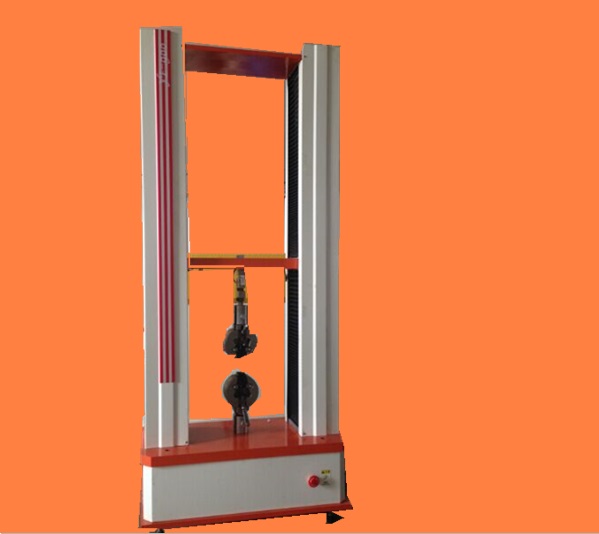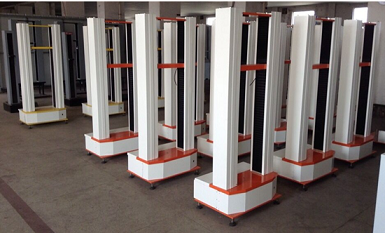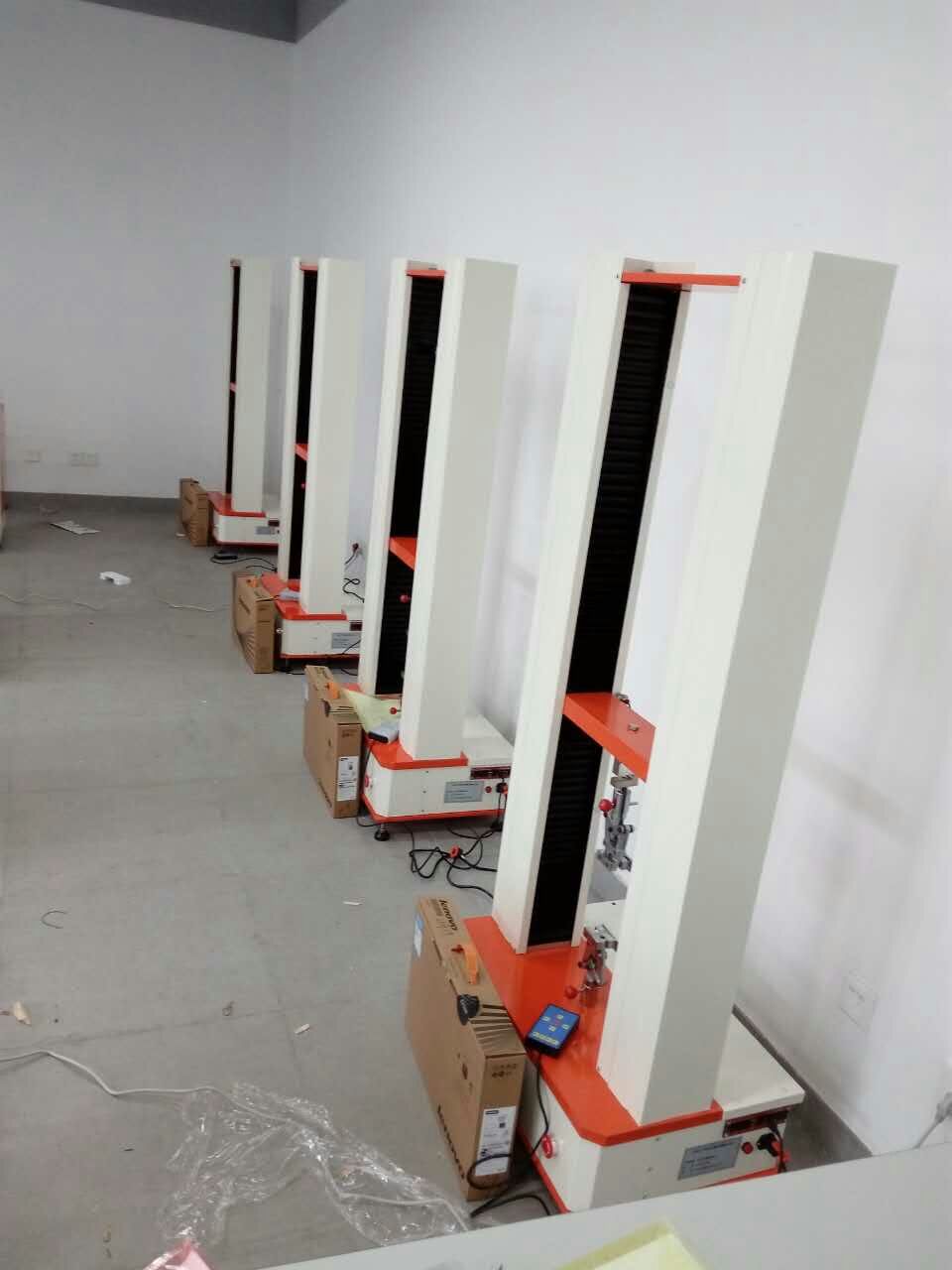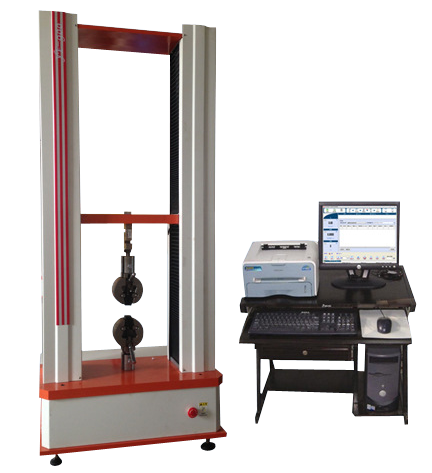
5KN電子拉力彎曲壓縮強度試驗機 Experimental steps
1. Tensile test
5KN電子拉力彎曲壓縮強度試驗機 One is to select the measuring range based on the sample, hang and align it with the engraved line, and adjust the buffer valve to match the measuring range. The second is to turn on the power, start the oil pump, and open the oil delivery valve to make the piston rise and fall 200mm, 2-3 times. The third step is to raise the piston by 20mm to 40mm and align the pointer with the zero position. Fourthly, adjust the moving crossbeam to the appropriate position. Close the oil delivery valve, press the "open" and "clamp" buttons on the clamp, clamp the sample, and be sure to keep the sample in a vertical position and in the middle. Adjust the indicator disk speed according to the loading speed required by the experiment. The fifth step is to open the oil delivery valve and start loading, so that the rotation speed of the pointer is basically consistent with the speed of the tracking disc. After the sample is damaged, close the oil delivery valve, record the test data, return the passive needle to zero position, and remove the fractured sample. Seven is to repeat the content from two to six and continue with the next experiment.
2. Compression test
One is to select the range based on the test block, hang and align it with the engraved line, and adjust the buffer valve to match the range. The second is to connect the power supply, start the oil pump, open the oil delivery valve to make the piston rise a section, adjust the pointer to zero, and close the oil delivery valve. Thirdly, activate the loading speed indicator and adjust the indicator disk to rotate at a certain speed according to the loading speed. Fourthly, place the test block properly. The fifth step is to quickly adjust the oil delivery valve to the corresponding position, keeping the pointer and indicator plate rotating synchronously until the test block is crushed. Close the oil delivery valve and open the oil return valve. The sixth step is to record the test data and retract the driven needle. Seven is to remove the crushed test block. Repeat the content from four to eight until all test blocks are completed.
Technical parameters:
A. Test force (kN): 5kN
B. Measurement accuracy of testing machine: Level 1 (standard version)
C. Effective force range: 2% -100% FS/
D. Resolution: 1/300000
E. Relative error of indication: ? 1%
F. Speed adjustment range: 0.05-500mm/min (stepless speed regulation)
G. Accuracy: better than ? 1% of the indicated value
H. Force control rate control range: 0.05-5% FN
I. Measurement range: 0-999mm
J. Resolution: 0.001mm
K. Measurement accuracy: better than ? 1% of the indicated value
L. Power supply, power:~220V ? 10% 50Hz 0.5kW
M. Weight (kg): 120KG
N. Usage conditions: Temperature: 10 ? C to 35 ? C; Humidity: 30% -85%;
software documentation
a. Software system: software packages in both Chinese and English for Windows 2000/XP/Win7 platforms
b. Automatic storage: Test conditions, test results, calculation parameters, and gauge position are automatically stored.
c. Automatic return: After the experiment is completed, the crossbeam of the testing machine will automatically return to the initial position of the experiment.
d. Continuous test: After setting a batch of test parameters, continuous testing can be conducted.
e. Multiple curves: Multiple different curves can be displayed on the same graph, including load displacement, load time, displacement time, stress-strain, load two-point extension, and more.
f. Curve comparison: The curves of the same group of samples can be overlaid and compared on the same graph.
g. Report editing: Different report formats can be output according to user requirements.
h. Dynamic display: During the testing process, the load, elongation, displacement, and selected test curves are dynamically displayed in real-time on the main control screen as the test progresses.
i. Automatic scaling: In the experiment, if the coordinates of the load, elongation, and other curves are not selected properly, the coordinates can be automatically changed according to the size of the measured values. Ensure that the curve is displayed in a large format on the screen under all circumstances.
j. Peak holding: Throughout the entire testing process, the maximum drunk value of the test item is displayed on the screen window as the experiment progresses.
k. Execution standards: Meet various testing methods and standards such as GB, ISO, JIS, ASTM, DIN, etc.
試驗步驟
1.拉伸試驗
一是根據試樣選用量程,掛好 并對準刻線,并調整緩沖閥使之與量程范圍相適應。二是打開電源,啟動油泵,開啟送油閥讓活塞上升下降200mm,2次~3次。三是讓活塞上升20mm~40mm,調指針對準零位。四是調整移動橫梁至適當位置。關閉送油閥,按動夾頭“開”、“夾緊”按鈕,夾緊試樣,必須注意使試樣處于鉛垂并位于中間位置。按試驗要求的加荷速度調整指示盤轉速。五是打開送油閥開始加荷,使指針的旋轉速度與跟蹤盤的速度基本保持一致。六是試樣破壞后,關閉送油閥,記錄試驗數據,將被動針撥回零位,取下斷裂的試樣。七是重復二到六的內容繼續下一試驗。
2.抗壓試驗
一是根據試塊選用量程,掛好 并對準刻線,并調整緩沖閥使之與量程范圍相適應。二是接通電源,啟動油泵,打開送油閥使活塞上升一段,調指針對零,關閉送油閥。三是啟動加載速度指示器,根據加載速度,調整指示盤以一定的轉速旋轉。四是放好試塊。五是迅速將送油閥調到相應位置,應保持指針與指示盤同步旋轉,直至試塊壓碎,關閉送油閥,打開回油閥。六是記錄試驗數據,撥回從動針。七是清除被壓碎試塊。八是重復四到八的內容直至所有試塊做完。
測試項目:(普通顯示值及計算值)
★拉伸應力 ★拉伸強度
★扯斷強度 ★扯斷伸長率
★定伸應力 ★定應力伸長率
★定應力力值 ★撕裂強度
★任意點力值 ★任意點伸長率
★抽出力 ★粘合力及取峰值計算值
試驗機儀表:
本儀表采用國際比較先進的放大器,A/D、微處理器、高性能高清晰的液晶顯示屏構成,整個系統采用類似手機PDA鍵盤,光標導航,全中文顯示,浮點數數據處理,結構簡單操作方便,自動計算存儲,適合于企業,質檢單位材料力學性能檢測儀表。
注意事項:
1初次開機前,請檢查各種連線的準確性以及輸入電源的正確性,電源一定為交流220V交流電源,接地良好。
2試驗前,請正確設置試驗參數,以保證試驗數據的準確性。
結構特征及工作原理
本機由機械、電氣二大部分組成(見附圖)。
1機械部分結構及工作原理:
本機采用電動加載方式,底部是整機結構承載支架,內部包含有電機驅動器、加載電機、減速機構、動力傳動機構等部件;上部是試樣夾持及力值、位移測量機構,包含有試樣拉伸夾具、測力傳感器、位移傳感器等主要部件。
2 電氣部分:
電氣部分由顯示測量控制部分組成。顯示測量控制部分實現各種控制、顯示、數據采集、處理等功能。軟件部分的操作請仔細閱讀《軟件說明書》。
3 本機的幾項主要功能:
3.1 全開放性參數設置
3.2 設置參數保存
3.3 浮動零點設置,可隨時調整零點
3.4 峰值保持及存儲,常值跟隨;
3.5 在有效速度范圍內,速度值任意設置;
3.6 橫梁移動過程中的速度快捷切換功能
3.7 靈活的數據查詢顯示功能;
3.8 過載停機保護功能;
3.9 試驗結束自動判斷功能;
3.10 極限位置保護等;
開關機注意事項:
1開機時主機和計算機的開機順序會影響計算機的通訊初始化設置,所以務必請用戶嚴格按照上述開機順序進行。
2每次開機后要預熱5分鐘,待系統穩定后,才可進行試驗工作。
3如果剛剛開機,需要再開機,至少保證1分鐘的間隔時間。
4在更換夾具后,首先要注意調整好可調擋圈(上下限位開關)。
5尤其在用小力值傳感器做試驗時,一定要調整好可調擋圈的位置,以免操作失誤而損壞小力值傳感器。不要超過傳感器的額定量程。
6任何時候都不能帶電插撥電源線,否則很容易損壞電氣控制部分。
7試驗過程中,不能遠離試驗機。
8試驗過程中,除停止按鍵和急停開關外,不要按控制盒上的其它按鍵,否則會影響試驗。
9試驗結束后,一定要關閉所有電源。
10本計算機是專門用于試驗機控制和數據處理的,請勿在計算機內安裝其它應用軟件,以免試驗機應用軟件不能正常運行。
11計算機要嚴格按照系統要求一步一步退出,正常關機,否則會損壞部分程序,導致軟件無法正常使用。
12不要使用來歷不明或與本機無關的軟盤在試驗機控制用計算機上寫盤或讀盤,以免病毒感染。
6.1 檢驗用器具
檢驗試驗機用的標準儀器、量具和檢具如下:
a) 符合GB/T 13634—2000第7章規定的標準測力儀或力的測量準確到?0.1%以內的專用檢驗砝碼;
b) 最大允許測量誤差為?2%的同軸度自動測試儀(或準確度與其相當的其他測量裝置)或重錘;
c) 表面粗糙度測試儀;
d) 洛氏硬度計;
e) 分辨力為1/100s的秒表;
f) (0~30)mm量程的1級百分表、(0~1)mm量程的1級千分表和磁力表座,1 000mm量程最大允許誤差為0.2mm的鋼直尺;
g) 0.02mm/m的水平儀;
h) 2級聲級計;
i) 符合JB 6146-2007中6.2.1規定的引伸計標定器;
j) 絕緣電阻測試儀;
k) 耐電壓測試儀;
l) 通用量具;
m) 鋼制或銅與鋁制的同軸度檢驗試樣(標距不小于100mm,標距部分直徑通常為10mm或12mm,標距部分與兩頭部的同軸度為φ0.02mm);
n) 各種試樣(試樣的數量應與拉力鉗口的套數相同,試樣的截面尺寸應適合各種圓試樣和板試樣的拉力鉗口)。
試驗機應有銘牌,其內容包括:
a) 名稱;
b) 型號;
c) 試驗機最大容量;
d) 試驗機級別;
e) 出廠日期、編號;
f) 制造廠名稱或標志。
校準
校準是調整精度的關鍵部分,試驗機的準確度關鍵步驟,具有自動校準,輸入數據后一鍵完成功能,當掛上砝碼,目標值輸入你要矯正值后按確定鍵,儀表自動將數值校正。
進入校準界面,按‘標定’鍵,進入密碼輸入界面顯示
‘密碼:000000’輸入系統默認密碼123456進入校準界面,進入后界面顯示當前力值,峰值、位移、目標值、速度。在系統校準模式下速度是利用導航鍵進行調整(0.1-50mm/min)用此速度進行壓測力計操作。
備注:設備在出廠時已經校準完畢,可以直接進行試驗操作。
北廣產品銷往北京、上海、廣東、河南、浙江、河北、江蘇、湖南、內蒙、山東、四川、廣州、江西、西北、云南、深圳、吉林、南京、嘉興、佛山、蘇州、杭州、西安、潥陽、長春、江蘇、平頂山、安徽、金水、金華、海南、廊坊、天津、成都、揚州、東莞、濟南、南通、株洲、保定、貴州、宜興、嘉興、黑龍江、漳州、成都、重慶、咸陽、濟南、紹興、杭州、拉薩、山西、惠州、滄州、江西、沈陽、武漢、沈陽、昆明、鶴山、許昌、青海、寧波、醴陵、淄博、瑞安、阜新、合肥、長沙、常州、瑞安、青島、無錫、濟寧、醴陵、廈門、河源、樂清、煙臺、福州、龍口、徐州、唐山等地銷售。
產品保修承諾:
1、免費送貨到用戶指定的地點,免費指導安裝、培訓及調試。
2、保修期內人為損壞的零部件按采購(加工)價格收費更換。
3、保修期外繼續為用戶提供優質技術服務,在接到用戶維修邀請后3天內派工程師到達用戶現場進行維修。并享有優惠購買零配件的待遇。
4、傳感器過載及整機電路超壓損壞不在保修范圍內。
5、產品質保期:自安裝正常使用日起一年;
6、軟件升級:終生免費提供新版本控制軟件。
業務咨詢:932174181 媒體合作:2279387437 24小時服務熱線:15136468001 盤古機械網 - 全面、科學的機械行業免費發布信息網站 Copyright 2017 PGJXO.COM 豫ICP備12019803號